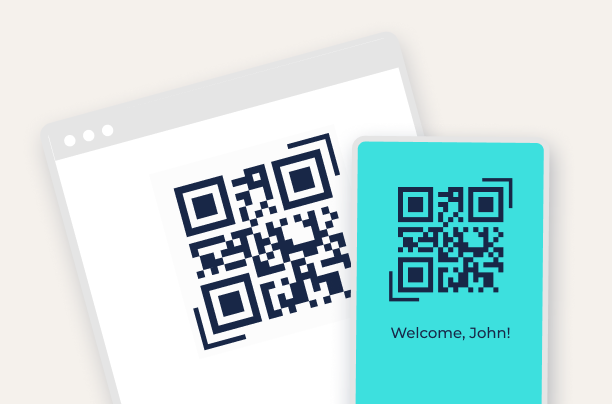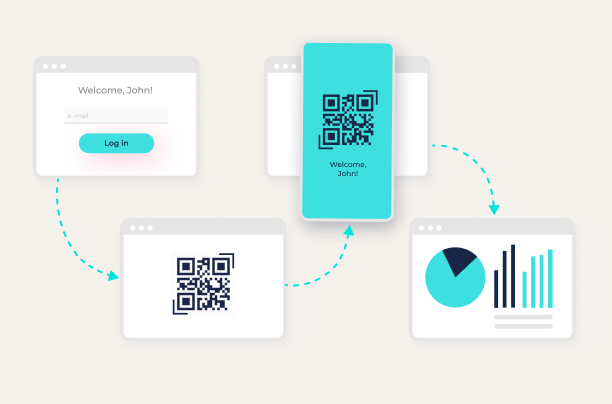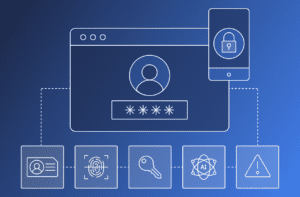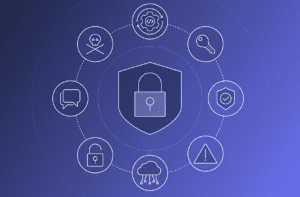Once widely used in the automobile industry, these two or three-dimensional scannable images of black squares on a white background have now expanded into many other industries.
QR codes, also known as Quick Response Codes, store a hundred times more data than a barcode and deliver it more quickly than the Universal Product Codes (UPC) found on the packages of retail products. The widespread adoption of mobile phones has also now made them a more practical solution for organizations.
How Do QR Codes Work?

Here’s how the data is delivered through a QR code in 6 basic steps:
- A user scans a QR code with a mobile phone camera.
- The phone camera scanner first identifies three position markers at the corners of the image (circles).
- The scanner begins its scan with the square on the bottom-right of the image (arrow), the mode indicator. A mode indicator is a group of four data modules that tell the scanner which type of data is being delivered (numeric, alphanumeric, byte, or kanji).
- It then continues its scan to the character count indicator, a group of eight data modules located above the mode indicator. This communicates the number of characters embedded in the code.
- The scanner continues along all of the data modules, finishing when it hits the end indicator.
- It continues to scan the error correction modules. These are mathematical formulas that essentially help back up the code in the event of a damaged QR code.
What is QR Code Authentication?
QR code authentication is a type of phone-as-a-token authentication that helps identify a user. Traditional QR codes help organizations implement multi-factor authentication for their users by using the QR code to generate a time-based one-time password (TOTP).
Passwords, however, are not the most secure method for authentication, since they can easily be phished for attacks such as Account Takeover (ATO). They are also difficult to remember and can frustrate the user experience.
How Secure are QR Codes?
While QR codes themselves cannot be hacked, cybercriminals are increasingly creating fake QR codes that direct users to malicious websites, leading to fraud and identity theft. Unfortunately, these fraudulent QR codes can be impossible to detect. Organizations considering implementing QR code authentication must understand these risks and use a trustworthy source for QR code generation rather than relying on a free online generator. QR codes that use biometric authentication in their technology can also reduce security risks.
Pros and Cons of QR Code Authentication
QR code authentication, especially when implemented through a trusted source, has a range of benefits.
Pros of QR Code Authentication
A few of the main advantages of QR code authentication include:
- Versatility: QR codes can embed many types and large amounts of data. As a result, they can be used on a wide range of products in a variety of industries.
- Accessibility to more data: Since they eliminate friction, QR codes can be an efficient way for organizations to gather customer and marketing data. They can then use the data to measure the effectiveness of certain marketing campaigns, for example.
- Elimination of friction: QR codes create a user-friendly experience for users who don’t want the inconvenience of remembering different passwords.
Cons of QR Code Authentication
In addition to the security concerns mentioned, QR codes have other disadvantages as well.
- Limited to tech-friendly users and environments: Although QR codes create a user-friendly experience for many, not all users always have a mobile phone available or understand the technology well enough for them to use it quickly and effectively. They also aren’t effective in areas without reliable wi-fi connectivity.
- Customer privacy: The sharing of massive amounts of data creates concerns for customer privacy. Organizations will need to make sure they act in accordance with the data collection, consent, and privacy regulations of their region when implementing QR technology.
QR Codes with Biometric Authentication
A more secure alternative to traditional QR code authentication is biometric authentication. Biometric authentication offers maximum security since they are using physiological or behavioral traits that are unique for each individual. The most common forms of biometric authentication are fingerprint readings, facial and voice recognition, and eyeball scans but they can also include heart-rate scans or typing patterns. In addition to offering greater security, they also offer a more seamless authentication experience for the user.

Use cases for QR codes
Since QR codes allow more data to be stored and delivered more quickly than previous solutions, they have applications in many sectors. They have also been widely adopted widespread adoption as the world has experienced rapid digital transformation.
Retail and Storage
One of the most common uses of QR in the retail space is as a tool for inventory management and manufacturing. However, they have also gained popularity with the rise of digital shopping. Retailers now place them on products to reveal personalized discounts for customers, on social media to drive more engagement through loyalty programs, and on payment systems to help meet the increasing demand for contactless payments. They can also be used so that customers can quickly reach customer support through the phone or email.
Travel and Hospitality
The travel industry places QR codes strategically on different tourist destinations and attractions to both advertise and provide additional travel information. The airline industry uses QR codes to verify boarding passes, and the hotel industry uses them for contactless dining and to provide its guests with faster check-ins.
Healthcare
With massive amounts of sensitive and confidential patient data in its possession, QR codes help increase security in the healthcare sector. They are used to verify patient ID cards and deliver medical staff important medical history in emergencies. They can also authenticate pharmaceuticals and help prevent counterfeit sales.
Government
Governments of countries have started using QR codes to implement digital voter ID cards, verify official documents, and authenticate website logins to their services. Some cities such as Seoul have even used QR codes for more efficient management of trash bins.
Improving Security with QR Code Authentication
Using biometric authentication with QR codes allows organizations to verify data while maximizing security. As a passwordless authentication service that organizations can quickly deploy, it also eliminates friction for its users.






